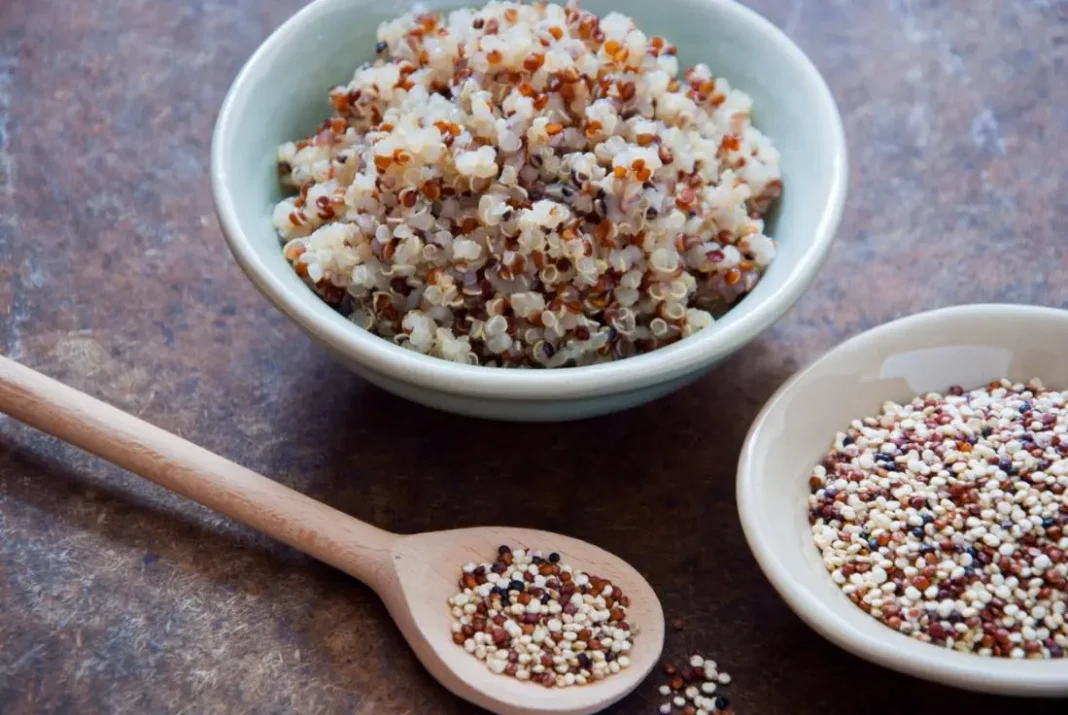Quinoa is a whole grain that is rapidly growing in popularity due to its many health benefits.
Although people can cook and eat quinoa seeds in a similar way to most grains, the quinoa plant itself is more similar to beetroots and spinach. People can eat both the seeds and leaves of this versatile, nutritious plant.
Farmers cultivate over 120 different types of quinoa. However, the most common versions available in grocery stores are white, red, and black quinoa.
In this article, we explain the evidence-based health benefits of quinoa. We also look at the nutritional content of quinoa and how to add it to the diet.
Benefits
Below are some of the health benefits of regularly consuming quinoa.
A plant-based source of protein
People following a plant-based diet need to find nonanimal sources of protein to ensure they are getting enough.
One cup of cooked quinoa weighing 185 grams (g) provides 8.14 g of protein.
The proteins in quinoa offer a wide range of amino acids (Trusted Source). Amino acids are vital for supporting muscle development (Trusted Source) and immune activity, among other essential functions.
This makes quinoa an excellent dietary choice for people following a vegetarian or vegan diet.
Quinoa, unlike many other grains, is also an excellent source (Trusted Source) of lysine. This is an essential amino acid. Lysine is vital for the synthesis of proteins. Although deficiency is rare, it can cause a range of medical issues, as lysine plays a role in processes such as growth and development.
High fiber content
Quinoa has a high fiber content compared with other grains, providing 5.18 g in a single 185 g cup. This equates to at least 15.42% of a person’s daily requirement, depending on their age and sex.
According to the Academy of Nutrition and Dietetics, consuming enough fiber can help reduce the risk of several health conditions, including constipation, high cholesterol, high blood pressure, and diverticulosis.
Diets rich in fiber may also promote a healthy weight. This is because foods high in fiber help people feel fuller for longer, potentially reducing their overall intake of food.
Here, learn more about why people need dietary fiber.
A source of antioxidants
Quinoa is a good source of antioxidants compared with other common grains in a gluten-free diet. Most gluten-free products consist of corn, rice, or potato flour. These generally provide fewer nutrients (Trusted Source) than products using quinoa, such as quinoa flour.
Quinoa provides vitamin E. This is an antioxidant compound that may help reduce the risk (Trusted Source) of coronary heart disease, certain cancers, and several eye disorders.
New studies regularly emerge that confirm the health benefits of adequate whole grain intake and their antioxidant capacity.
Helps meet manganese requirements
One cup of cooked quinoa contains 1.17 milligrams (mg) of manganese. This accounts for around 27.43% of the adequate intake of manganese for males and 35.05% for females.
Manganese is essential for development and metabolism (Trusted Source). This element also works alongside many enzymes in the body to support their function.
Good source of iron
One cup of quinoa supplies 2.76 mg of iron, providing 34.5% of the recommended intake for males and 15.33% for females. Maintaining adequate levels of iron is essential for good health.
Iron is necessary for a range of processes (Trusted Source) in the human body. It is, for example, an essential part of hemoglobin. This compound carries oxygen in the blood, supporting energy and cell function throughout the body.
Adequate iron intake also supports healthy connective tissue and muscle metabolism.
Read more on the role of iron in the body.
A source of folate
Folate is an essential B vitamin that plays a key role in the formation of DNA (Trusted Source). It is particularly important that women obtain enough folate during pregnancy to reduce the chance of neural tube defects in their babies, according to the Office of Dietary Supplements (ODS).
Getting enough dietary folate might also reduce the risk of several cancers and depression.
One cup of cooked quinoa contains 77.7 micrograms (mcg) of folate, or 19.43%of the daily requirement.
Pregnant women may only be able to get enough folate by taking folic acid supplements. However, consuming more folate in the diet can reduce the risk of deficiency. Quinoa provides a good proportion of a person’s daily folate value.
Provides magnesium
One cup of cooked quinoa contains 118 mg of magnesium. Although the daily recommended amount increases with age, quinoa is a good source of the mineral.
Magnesium is essential for the function of more than 300 enzymatic reactions and is present in every cell of the body.
The ODS suggest that low levels of magnesium have possible links (Trusted Source) to the following health concerns:
- high blood pressure
- cardiovascular disease
- type 2 diabetes
- migraine
However, more research is necessary to confirm the effects of dietary magnesium on these conditions.
Contains quercetin and kaempferol
Quinoa contains the plant compounds quercetin and kaempferol.
These antioxidants may protect (Trusted Source) against a range of chronic conditions. For example, according to some research, kaempferol may help protect against infection, heart disease, diabetes, and several cancers, including those of the skin and liver.
Quercetin may also help boost the body’s defenses (Trusted Source) against infection and inflammation.
Nutrition
Plant experts classify quinoa as a pseudocereal, not a grain. This means that it is a nongrassy plant that food producers can use in much the same way as cereals and grains. It also has a similar nutritional profile.
Manufacturers can mill or grind the seeds of pseudograins into flour, as with other grains and cereals.
Nutritionally, quinoa is a whole grain. Whole grains include the entire grain seed without removing any of its parts.
Whole grains provide essential vitamins, minerals, and fiber that might otherwise not be available after removing parts of the grain.
Quinoa is naturally gluten-free.
One cup of cooked quinoa provides:
- 222 calories
- 8.14 g of protein
- 5.18 g of fiber
- 3.55 g of fat, of which 0.42 g is saturated
- 39.4 g of carbohydrate
Quinoa is highly nutritious and can provide a large portion of a person’s daily requirement or adequate intake for several important nutrients, including:
| Nutrient | Percentage of daily requirement for adults |
| Magnesium | At least 28.10%, depending on sex and age |
| Manganese | 27.43% for males, and 25.05% for females |
| Folate | 19.43% |
| Phosphorus | 40.14% |
| Copper | 39.44% |
| Iron | 34.5% for males, and 15.33% for females |
| Zinc | 18.36% for males, and 25.25% for females |
| Potassium | 6.77% |
| Vitamin B-1 | 16.5% |
| Riboflavin | 18.55% for males, and 10% for females |
| Vitamin B-6 | Around 17.54%, depending on age |
The same amount of quinoa contains traces of vitamin E, vitamin B-3, and calcium.
Diet
Quinoa contains bitter tasting compounds called saponins that keep insects away without the need of pesticides. They are especially concentrated in the outer coating of quinoa.
Manufacturers can easily remove saponins by rinsing quinoa with water (Trusted Source) before consumption.
Although producers of most packaged quinoa have already removed most of the saponins, people may wish to give it an extra rinse before consuming it.
It is easy to incorporate quinoa into the diet. People can use it instead of rice in any recipe. Its small grains cook to tender in as little as 15 minutes.
Quinoa has a subtle nutty taste that makes it a very versatile ingredient. It can play a role in baking or as a breakfast grain. Quinoa also works well in hot side dishes, cold salads, and burgers.
Try these healthful quinoa recipes:



